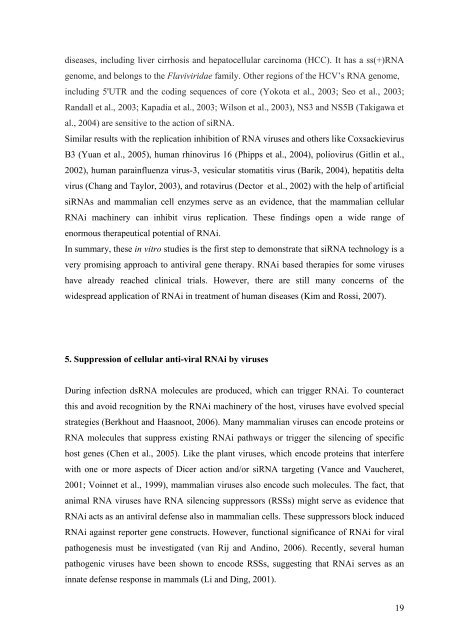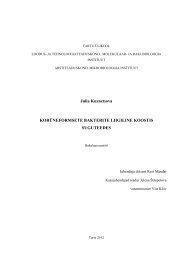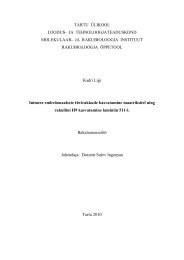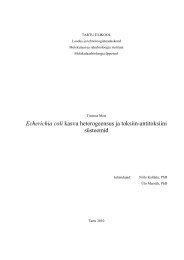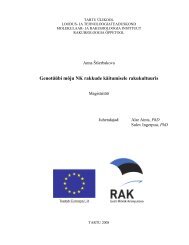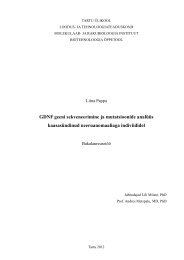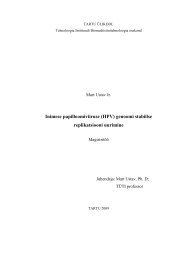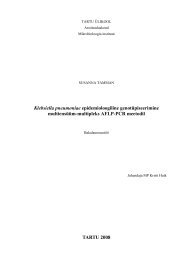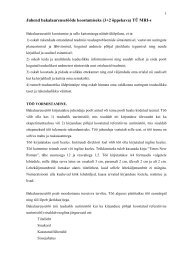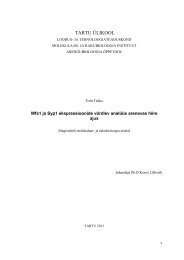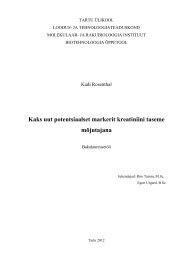Viruses and RNA interference in mammalian cells
Viruses and RNA interference in mammalian cells
Viruses and RNA interference in mammalian cells
You also want an ePaper? Increase the reach of your titles
YUMPU automatically turns print PDFs into web optimized ePapers that Google loves.
diseases, <strong>in</strong>clud<strong>in</strong>g liver cirrhosis <strong>and</strong> hepatocellular carc<strong>in</strong>oma (HCC). It has a ss(+)<strong>RNA</strong><br />
genome, <strong>and</strong> belongs to the Flaviviridae family. Other regions of the HCV’s <strong>RNA</strong> genome,<br />
<strong>in</strong>clud<strong>in</strong>g 5'UTR <strong>and</strong> the cod<strong>in</strong>g sequences of core (Yokota et al., 2003; Seo et al., 2003;<br />
R<strong>and</strong>all et al., 2003; Kapadia et al., 2003; Wilson et al., 2003), NS3 <strong>and</strong> NS5B (Takigawa et<br />
al., 2004) are sensitive to the action of si<strong>RNA</strong>.<br />
Similar results with the replication <strong>in</strong>hibition of <strong>RNA</strong> viruses <strong>and</strong> others like Coxsackievirus<br />
B3 (Yuan et al., 2005), human rh<strong>in</strong>ovirus 16 (Phipps et al., 2004), poliovirus (Gitl<strong>in</strong> et al.,<br />
2002), human para<strong>in</strong>fluenza virus-3, vesicular stomatitis virus (Barik, 2004), hepatitis delta<br />
virus (Chang <strong>and</strong> Taylor, 2003), <strong>and</strong> rotavirus (Dector et al., 2002) with the help of artificial<br />
si<strong>RNA</strong>s <strong>and</strong> <strong>mammalian</strong> cell enzymes serve as an evidence, that the <strong>mammalian</strong> cellular<br />
<strong>RNA</strong>i mach<strong>in</strong>ery can <strong>in</strong>hibit virus replication. These f<strong>in</strong>d<strong>in</strong>gs open a wide range of<br />
enormous therapeutical potential of <strong>RNA</strong>i.<br />
In summary, these <strong>in</strong> vitro studies is the first step to demonstrate that si<strong>RNA</strong> technology is a<br />
very promis<strong>in</strong>g approach to antiviral gene therapy. <strong>RNA</strong>i based therapies for some viruses<br />
have already reached cl<strong>in</strong>ical trials. However, there are still many concerns of the<br />
widespread application of <strong>RNA</strong>i <strong>in</strong> treatment of human diseases (Kim <strong>and</strong> Rossi, 2007).<br />
5. Suppression of cellular anti-viral <strong>RNA</strong>i by viruses<br />
Dur<strong>in</strong>g <strong>in</strong>fection ds<strong>RNA</strong> molecules are produced, which can trigger <strong>RNA</strong>i. To counteract<br />
this <strong>and</strong> avoid recognition by the <strong>RNA</strong>i mach<strong>in</strong>ery of the host, viruses have evolved special<br />
strategies (Berkhout <strong>and</strong> Haasnoot, 2006). Many <strong>mammalian</strong> viruses can encode prote<strong>in</strong>s or<br />
<strong>RNA</strong> molecules that suppress exist<strong>in</strong>g <strong>RNA</strong>i pathways or trigger the silenc<strong>in</strong>g of specific<br />
host genes (Chen et al., 2005). Like the plant viruses, which encode prote<strong>in</strong>s that <strong>in</strong>terfere<br />
with one or more aspects of Dicer action <strong>and</strong>/or si<strong>RNA</strong> target<strong>in</strong>g (Vance <strong>and</strong> Vaucheret,<br />
2001; Vo<strong>in</strong>net et al., 1999), <strong>mammalian</strong> viruses also encode such molecules. The fact, that<br />
animal <strong>RNA</strong> viruses have <strong>RNA</strong> silenc<strong>in</strong>g suppressors (RSSs) might serve as evidence that<br />
<strong>RNA</strong>i acts as an antiviral defense also <strong>in</strong> <strong>mammalian</strong> <strong>cells</strong>. These suppressors block <strong>in</strong>duced<br />
<strong>RNA</strong>i aga<strong>in</strong>st reporter gene constructs. However, functional significance of <strong>RNA</strong>i for viral<br />
pathogenesis must be <strong>in</strong>vestigated (van Rij <strong>and</strong> And<strong>in</strong>o, 2006). Recently, several human<br />
pathogenic viruses have been shown to encode RSSs, suggest<strong>in</strong>g that <strong>RNA</strong>i serves as an<br />
<strong>in</strong>nate defense response <strong>in</strong> mammals (Li <strong>and</strong> D<strong>in</strong>g, 2001).<br />
19


